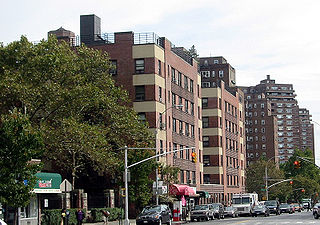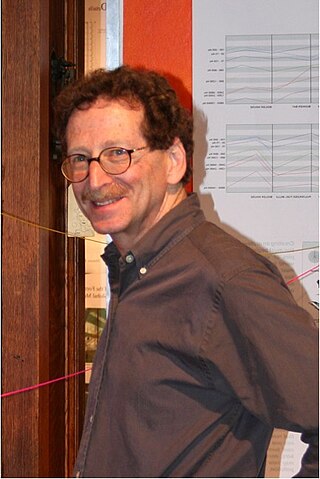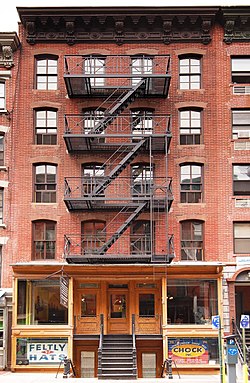
Alphabet City is a neighborhood located within the East Village in the New York City borough of Manhattan. Its name comes from Avenues A, B, C, and D, the only avenues in Manhattan to have single-letter names. It is bounded by Houston Street to the south and 14th Street to the north, and extends roughly from Avenue A to the East River. Some famous landmarks include Tompkins Square Park, the Nuyorican Poets Cafe and the Charlie Parker Residence.

An apartment, flat, or unit is a self-contained housing unit that occupies part of a building, generally on a single storey. There are many names for these overall buildings. The housing tenure of apartments also varies considerably, from large-scale public housing, to owner occupancy within what is legally a condominium, to tenants renting from a private landlord.

The Lower East Side, sometimes abbreviated as LES, is a historic neighborhood in the southeastern part of Manhattan in New York City. It is located roughly between the Bowery and the East River from Canal to Houston streets. Historically, it was understood to encompass a much larger area, from Broadway to the East River and from East 14th Street to Fulton and Franklin Streets.

A tenement is a type of building shared by multiple dwellings, typically with flats or apartments on each floor and with shared entrance stairway access. They are common on the British Isles, particularly in Scotland. In the medieval Old Town, in Edinburgh, tenements were developed with each apartment treated as a separate house, built on top of each other. Over hundreds of years, custom grew to become law concerning maintenance and repairs, as first formally discussed in Stair's 1681 writings on Scots property law. In Scotland, these are now governed by the Tenements Act, which replaced the old Law of the Tenement and created a new system of common ownership and procedures concerning repairs and maintenance of tenements. Tenements with one or two room flats provided popular rented accommodation for workers, but in some inner-city areas, overcrowding and maintenance problems led to shanty towns, which have been cleared and redeveloped. In more affluent areas, tenement flats form spacious privately owned houses, some with up to six bedrooms, which continue to be desirable properties.
The New York State Tenement House Act of 1901 banned the construction of dark, poorly ventilated tenement buildings in the U.S. state of New York. Among other sanctions, the law required that new buildings must be built with outward-facing windows in every room, an open courtyard, proper ventilation systems, indoor toilets, and fire safeguards. One of the reforms of the Progressive Era, it was one of the first laws of its kind in the U.S.
The history of New York City (1855–1897) started with the inauguration in 1855 of Fernando Wood as the first mayor from Tammany Hall, an institution that dominated the city throughout this period. Reforms led to the New York City Police Riot of June 1857. There was chaos during the American Civil War, with major rioting in the New York Draft Riots. The Gilded Age brought about prosperity for the city's upper classes amid the further growth of a poor immigrant working class, as well as an increasing consolidation, both economic and municipal, of what would become the five boroughs in 1898.

The West End is a neighborhood of Boston, Massachusetts, United States, bounded generally by Cambridge Street to the south, the Charles River to the west and northwest, North Washington Street on the north and northeast, and New Sudbury Street on the east. Beacon Hill is to the south, North Point is across the Charles River to the north, Kendall Square is across the Charles River to the west, and the North End is to the east. A late 1950s urban renewal project razed a large Italian and Jewish enclave and displaced over 20,000 people in order to redevelop much of the West End and part of the neighboring Downtown neighborhood. After that, the original West End became increasingly non-residential, including part of Government Center as well as much of Massachusetts General Hospital and several high rise office buildings. More recently, however, new residential buildings and spaces, as well as new parks, have been appearing across the West End.

Orchard Street is a street in Manhattan which covers the eight city blocks between Division Street in Chinatown and East Houston Street on the Lower East Side. Vehicular traffic runs north on this one-way street. Orchard Street starts from Division Street in the south and ends at East Houston Street in the north..

Cooperative Village is a community of housing cooperatives on the Lower East Side of Manhattan, New York City. The cooperatives are centered on Grand Street in an area south of the entrance ramp to the Williamsburg Bridge and west of the FDR Drive. Combined, the four cooperatives have 4,500 apartments in twelve buildings.

Two Bridges is a neighborhood in the New York City borough of Manhattan, nestled at the southern end of the Lower East Side and Chinatown on the East River waterfront, near the footings of Brooklyn Bridge and of Manhattan Bridge. The neighborhood has been considered to be a part of the Lower East Side for much of its history. Two Bridges has traditionally been an immigrant neighborhood, previously populated by immigrants from Europe, and more recently from Latin America and China. The Two Bridges Historic District was listed in the National Register of Historic Places in September 2003.

New Law Tenements were built in New York City following the New York State Tenement House Act of 1901, so-called the "New Law" to distinguish it from the previous two Tenement House Acts of 1867 and 1879. New Law tenements are distinct from "Old Law" and "pre-law" tenements both in structural design and exterior ornament.

Andrew Scott Dolkart is a professor of Historic Preservation at the Columbia University Graduate School of Architecture, Planning and Preservation (GSAPP) and served as the Director of the school's Historic Preservation Program from 2008 to 2016.

Meserich Synagogue, Meserich Shul or Meseritz Shul, also known as Edes Israel Anshei Mesrich, Edath Lei'Isroel Ansche Meseritz or Adas Yisroel Anshe Mezeritz, is an Orthodox Jewish synagogue located at 415 East 6th Street, in the East Village of Manhattan, New York City, New York, in the United States.

First Houses is a public housing project in the East Village, Manhattan, New York City and was one of the first public housing projects in the United States. First Houses were designated a New York City Landmark and National Historic Landmark in 1974. They are managed by the New York City Housing Authority.
A Stoop on Orchard Street is a musical by Jay Kholos. The story, inspired by a visit to the Lower East Side Tenement Museum, is a nostalgic look at the year 1910. The musical premiered Off-Broadway in 2003, where it enjoyed a long run. It has since been revived several times.

Bernard M. Baruch Houses, or Baruch Houses, is a public housing development built by the New York City Housing Authority (NYCHA) on the Lower East Side of Manhattan. Baruch Houses is bounded by Franklin D. Roosevelt East River Drive to the east, E. Houston Street to the north, Columbia Street to the west, and Delancey Street to the south. The complex, the largest NYCHA development in Manhattan, occupies 27.64 acres (111,900 m2), of which buildings cover 13.4%, a percentage similar to that of most "tower in the park" project designs. It has 2,194 apartments, which house an estimated 5,397 people. These apartments are distributed throughout 17 buildings. Baruch Houses I is seven stories tall, Baruch Houses XI, XIII, and XV are thirteen stories tall, and the rest are fourteen stories tall. Combined, these buildings have 2.9 million square feet (270,000 m2).
Jane Ziegelman is director of the culinary program at New York City's Tenement Museum and author of 97 Orchard: An Edible History of Five Immigrant Families and Foie Gras: A Passion.

109 Washington Street is a five-story tenement in the Financial District of Manhattan in New York City, within the area once known as Little Syria. Due to demolitions connected to the construction of the Brooklyn–Battery Tunnel and the World Trade Center, it stands as the last tenement on a portion of lower Washington Street that has been estimated by Kate Reggev to have contained around 50 tenements. After September 11, 2001, its proximity to the World Trade Center site made it the subject of some media attention, including a nationally syndicated radio story about the experiences of its residents on the day of the attack. In recent years, community officials, activists, and preservationists have advocated for its designation as a landmark as part of a mini-historical district with the connected buildings of St. George's Syrian Catholic Church and the Downtown Community House.

The East Village/Lower East Side Historic District in Lower Manhattan, New York City was created by the New York City Landmarks Preservation Commission on October 9, 2012. It encompasses 330 buildings, mostly in the East Village neighborhood, primarily along Second Avenue between East 2nd and 6th Streets, and along the side streets. Some of the buildings are located in a second area between First Avenue and Avenue A along East 6th and 7th Streets. The district is based on the one which had been proposed by the Greenwich Village Society for Historic Preservation, with only minor changes, and is the result of a two-year effort to protect the area.

Essex Crossing is an under-construction mixed-use development in New York City's Lower East Side, at the intersection of Delancey Street and Essex Street just north of Seward Park. Essex Crossing will comprise nearly 2,000,000 sq ft (200,000 m2) of space on 6 acres and will cost an estimated US$1.1 billion. Part of the existing Seward Park Urban Renewal Area (SPURA), the development will sit on a total of nine city blocks, most of them occupied by parking lots that replaced tenements razed in 1967.






















